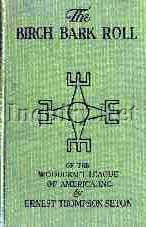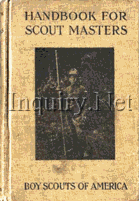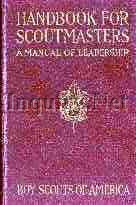A History of Boy Scout Aims
& The Methods of Scouting
 THE BIRCH
BARK ROLL(1902)
THE BIRCH
BARK ROLL(1902)
Ernest Thompson Seton
THE NINE IMPORTANT PRINCIPLES OF
WOODCRAFT:
1) This Movement is Essentially for Recreation;
2) Camp-Life, 3) Self-Government with Adult Guidance;
4) The Magic of the Campfire; 5) Woodcraft Pursuits;
6) Honors by Standards; 7) Personal Decoration for
Personal Achievements; 8) A Heroic Ideal;
9) Picturesqueness in Everything.
 THE BOY PIONEERS (1909)
THE BOY PIONEERS (1909)
Daniel Carter Beard
 SCOUTMASTERSHIP
SCOUTMASTERSHIP
Sir Robert Baden-Powell
I) Boy Training;
II) Character Training;
III) Physical Health and Development;
IV) Self-Improvement for Making a Career;
V) Service for Others (Chivalry and Self-Sacrifice the Basis of
Religion).
 HANDBOOK FOR
SCOUT MASTERS, 1st
Edition (1913)
HANDBOOK FOR
SCOUT MASTERS, 1st
Edition (1913)
SIX PRINCIPLES OF BOY-WORK
1) A Clear Plan, Well Thought Out, Progressive in its
Stages; 2) The Leader Should Tell the Boys What the Game is and How it is to be
Played; 3) Application of Self-Government; 4) The Scout Master as a Real
Leader; 5) Differences, "Scraps," and Misunderstandings; 6) Rules
and Infringements of Rules.
 HANDBOOK FOR SCOUTMASTERS, 2nd Ed. (1920)
HANDBOOK FOR SCOUTMASTERS, 2nd Ed. (1920)
THE NINE METHODS:
("Arranged in Order of their Appeal to Boys")
1) Play; 2) Competition; 3) Dramatization; 4) Experiment; 5) Observation; 6)
Demonstration; 7) Recitation; 8) Lecture; 9) Book Study
 HANDBOOK FOR SCOUTMASTERS, 3rd
Ed. (1936)
HANDBOOK FOR SCOUTMASTERS, 3rd
Ed. (1936)
FIVE ESSENTIAL ELEMENTS IN THE PROGRAM OF SCOUTING
1) The Boy---Individual, Patrol, Troop;
2) Leadership---Trained Volunteer--In Uniform;
3) Activity---Achievement with Recognition;
4) Organization---Institutional...
5) Scout Oath and Law--Ideals of Service.
 HANDBOOK FOR
SCOUTMASTERS, 4th Ed. (1947)
HANDBOOK FOR
SCOUTMASTERS, 4th Ed. (1947)
THE METHODS OF SCOUTING
The Scout Way (1. A Game, NOT a Science); Patrol Method (2.
Scout Patrol & 3. Boy Leadership); Men in Scouting (4.
Scoutmaster, 5. Committee & Council) Activities (6. Adventure
in the Out-of-Doors & 7. Advancement); Uniform (8. Scout
Uniform); Ideals & Service ( 9. Scout Law, 10. Oath, Service,
Good Turns).
 SCOUTMASTER'S
HANDBOOK, 5th Ed. (1959)
SCOUTMASTER'S
HANDBOOK, 5th Ed. (1959)
THE METHODS OF SCOUTING
The Scout Way (1. A Game, NOT a Science); Patrol Method (2.
Scout Patrol & 3. Boy Leadership); Men in Scouting (4.
Scoutmaster, 5. Committee & Council) Activities (6. Adventure
in the Out-of-Doors & 7. Advancement); Uniform (8. Scout
Uniform); Ideals & Service ( 9. Scout Law, 10. Oath, Service,
Good Turns)
 SCOUTMASTER'S
HANDBOOK, 6th Ed. (1972)
SCOUTMASTER'S
HANDBOOK, 6th Ed. (1972)
THE SEVEN METHODS OF SCOUTING
1) Scouting Ideals;
2) Patrols;
3) Advancement;
4) Adult Male Association;
5) Outdoor Program;
6) Leadership Development;
7) Personal Growth.
 THE OFFICIAL SCOUTMASTER HANDBOOK,7th
Ed. (1981)
THE OFFICIAL SCOUTMASTER HANDBOOK,7th
Ed. (1981)
THE EIGHT METHODS OF SCOUTING
1) Ideals; 2) Patrol Method;
3) Outdoors; 4) Advancement;
5) Adult Male Association;
6) Uniform; 7) Leadership Training;
8) Personal Growth.
 The Scoutmaster Handbook, 8th
Ed. (1990)
The Scoutmaster Handbook, 8th
Ed. (1990)
THE EIGHT METHODS OF SCOUTING
1) Ideals; 2) Patrols;
3) Outdoors; 4) Advancement;
5) Personal Growth; 6) Adult Association;
7) Leadership Development;
8) The Uniform.
 The Scoutmaster Handbook, 9th Ed. (1999)
The Scoutmaster Handbook, 9th Ed. (1999)
THE EIGHT METHODS OF SCOUTING
1) The Ideals; 2) The Patrol Method;
3) The Outdoors; 4) Advancement;
5) Association with Adults; 6) Personal Growth;
7) Leadership Development;
8) The Uniform.